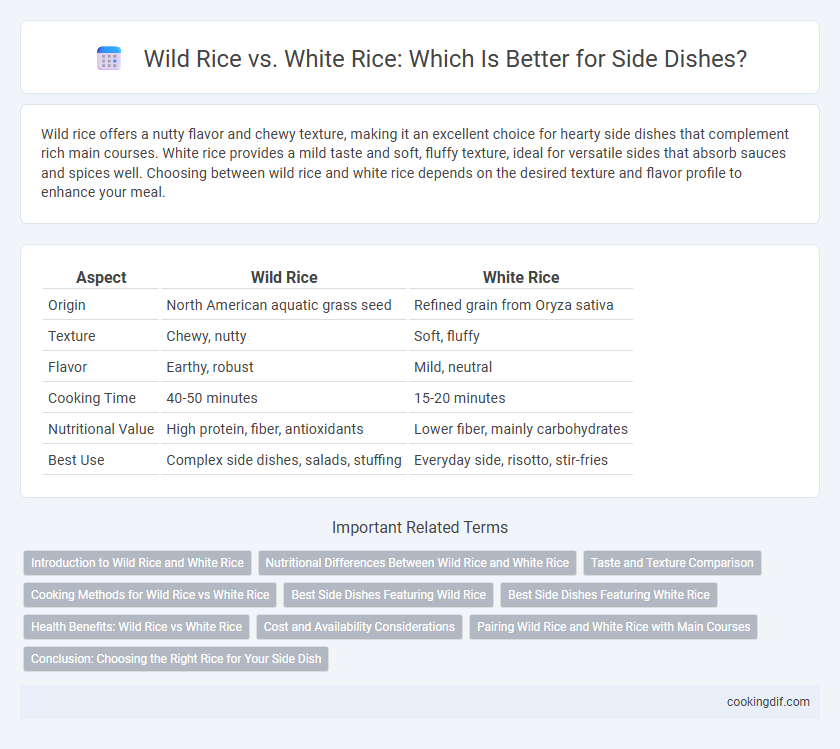Wild rice offers a nutty flavor and chewy texture, making it an excellent choice for hearty side dishes that complement rich main courses. White rice provides a mild taste and soft, fluffy texture, ideal for versatile sides that absorb sauces and spices well. Choosing between wild rice and white rice depends on the desired texture and flavor profile to enhance your meal.
Table of Comparison
| Aspect | Wild Rice | White Rice |
|---|---|---|
| Origin | North American aquatic grass seed | Refined grain from Oryza sativa |
| Texture | Chewy, nutty | Soft, fluffy |
| Flavor | Earthy, robust | Mild, neutral |
| Cooking Time | 40-50 minutes | 15-20 minutes |
| Nutritional Value | High protein, fiber, antioxidants | Lower fiber, mainly carbohydrates |
| Best Use | Complex side dishes, salads, stuffing | Everyday side, risotto, stir-fries |
Introduction to Wild Rice and White Rice
Wild rice, a nutrient-rich grain native to North America, offers a nutty flavor and chewy texture, making it an excellent choice for hearty side dishes. White rice, a polished grain with a mild taste and soft texture, is a versatile staple commonly used in a wide range of culinary traditions. Comparing wild rice vs white rice highlights differences in nutritional content, cooking time, and flavor profile important for selecting the best side dish option.
Nutritional Differences Between Wild Rice and White Rice
Wild rice contains higher protein content, fiber, and essential minerals like magnesium and zinc compared to white rice, offering greater nutritional benefits for side dishes. White rice, predominantly composed of carbohydrates, provides quick energy but lacks the dietary fiber and antioxidant properties found in wild rice. Choosing wild rice can enhance meal nutrition by supporting digestive health and providing a richer micronutrient profile.
Taste and Texture Comparison
Wild rice offers a robust, nutty flavor with a chewy texture that adds complexity to side dishes, making it ideal for hearty meals or salads. White rice features a mild, slightly sweet taste and a soft, fluffy texture that pairs well with a wide range of sauces and seasonings, providing a neutral base. The distinct firmness of wild rice contrasts with the smoothness of white rice, influencing the overall mouthfeel and complementing different culinary profiles.
Cooking Methods for Wild Rice vs White Rice
Wild rice requires a longer cooking time of 45-60 minutes and benefits from soaking to reduce hardness, whereas white rice cooks quickly in 15-20 minutes with a simple absorption method. Wild rice's firm texture and nutty flavor make it ideal for pilafs and grain salads, while white rice's soft, fluffy consistency pairs well with saucy dishes and stir-fries. Adjusting water ratios--typically 3 cups for wild rice to 1.5-2 cups for white rice--ensures optimal texture for each variety when preparing side dishes.
Best Side Dishes Featuring Wild Rice
Wild rice, with its nutty flavor and chewy texture, pairs exceptionally well with roasted vegetables, grilled meats, and hearty stews, making it a versatile and nutritious side dish option. Unlike white rice, wild rice boasts higher protein content and essential minerals such as magnesium and zinc, enhancing both taste and nutritional value. Side dishes featuring wild rice often include ingredients like mushrooms, cranberries, and nuts to complement its earthy profile and add texture.
Best Side Dishes Featuring White Rice
White rice serves as a versatile base for a variety of side dishes, complementing protein-rich mains like grilled chicken, teriyaki salmon, or spicy curries. It pairs well with vegetable stir-fries, steamed broccoli, and sauteed mushrooms, enhancing both texture and flavor balance. Its neutral flavor allows it to absorb sauces and spices, making it ideal for side dishes such as fried rice, pilaf, or rice salads.
Health Benefits: Wild Rice vs White Rice
Wild rice offers higher protein content and more fiber than white rice, supporting better digestion and prolonged satiety. Rich in antioxidants and minerals like magnesium and zinc, wild rice enhances immune function and overall cellular health. White rice provides quick energy due to its higher glycemic index but lacks the nutrient density found in wild rice, making wild rice the healthier choice for side dishes.
Cost and Availability Considerations
Wild rice generally costs more than white rice due to its labor-intensive harvesting process and limited growing regions, making it less readily available in mainstream grocery stores. White rice, with widespread production and efficient processing, remains more affordable and accessible for everyday side dishes. Choosing between the two depends on budget constraints and the desired availability within local markets.
Pairing Wild Rice and White Rice with Main Courses
Wild rice offers a nutty flavor and chewy texture that complements rich, savory main dishes like roasted meats and hearty stews, while white rice provides a mild, neutral base ideal for lighter dishes such as grilled chicken and seafood. Combining wild rice and white rice in side dishes creates a balanced contrast in texture and flavor, enhancing the overall meal variety. This pairing works well with diverse cuisines, from American comfort food to Asian-inspired plates, enriching the dining experience with both taste and visual appeal.
Conclusion: Choosing the Right Rice for Your Side Dish
Wild rice offers a nutty flavor and chewy texture ideal for hearty, savory side dishes, while white rice provides a mild taste and fluffy consistency that complements lighter meals. Nutritionally, wild rice is higher in protein and fiber, making it a healthier option for those seeking added nutrients. Selecting the right rice depends on your dish's flavor profile and dietary goals, with wild rice enhancing robust recipes and white rice maintaining simplicity.
Wild rice vs White rice for side dishes Infographic

 cookingdif.com
cookingdif.com